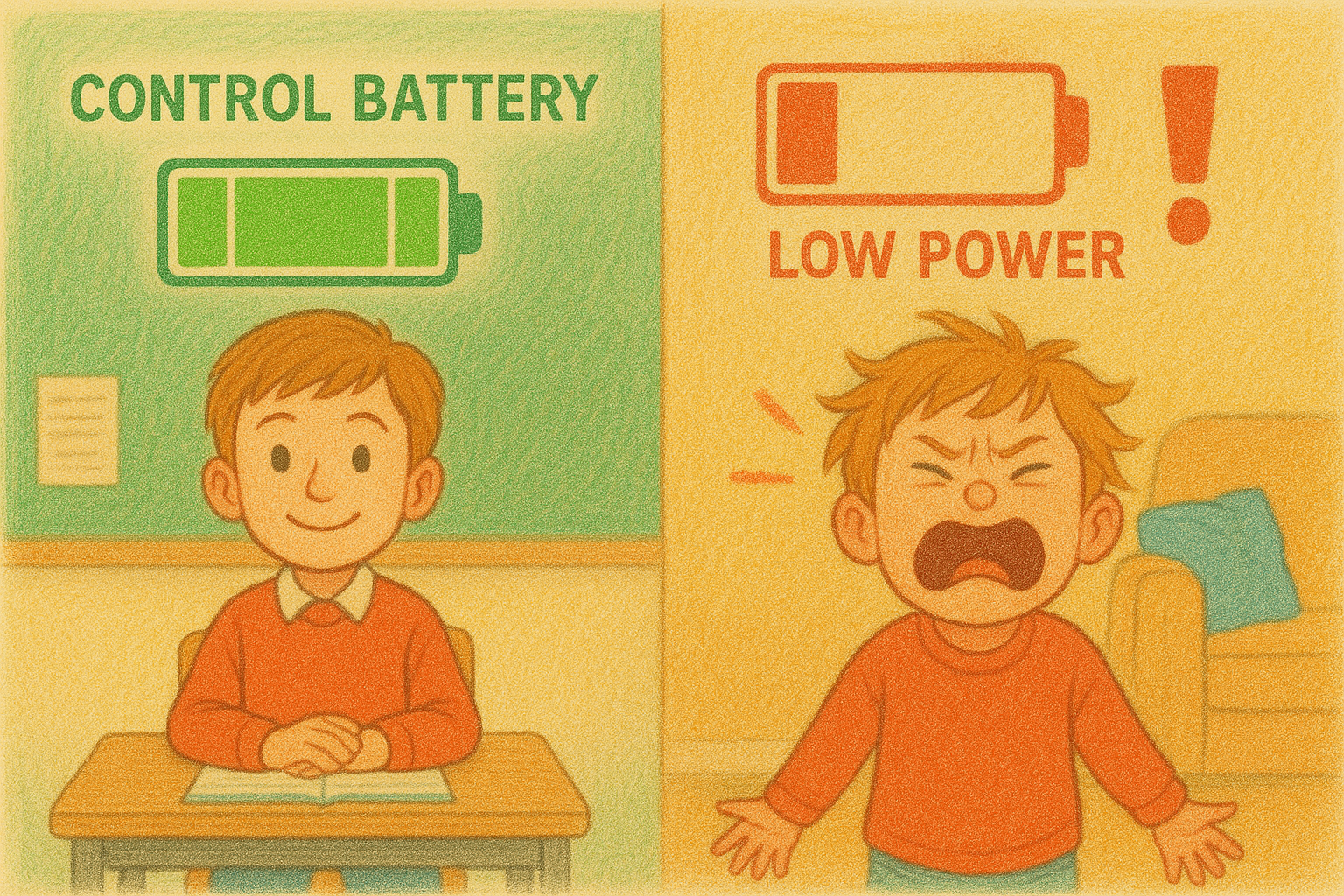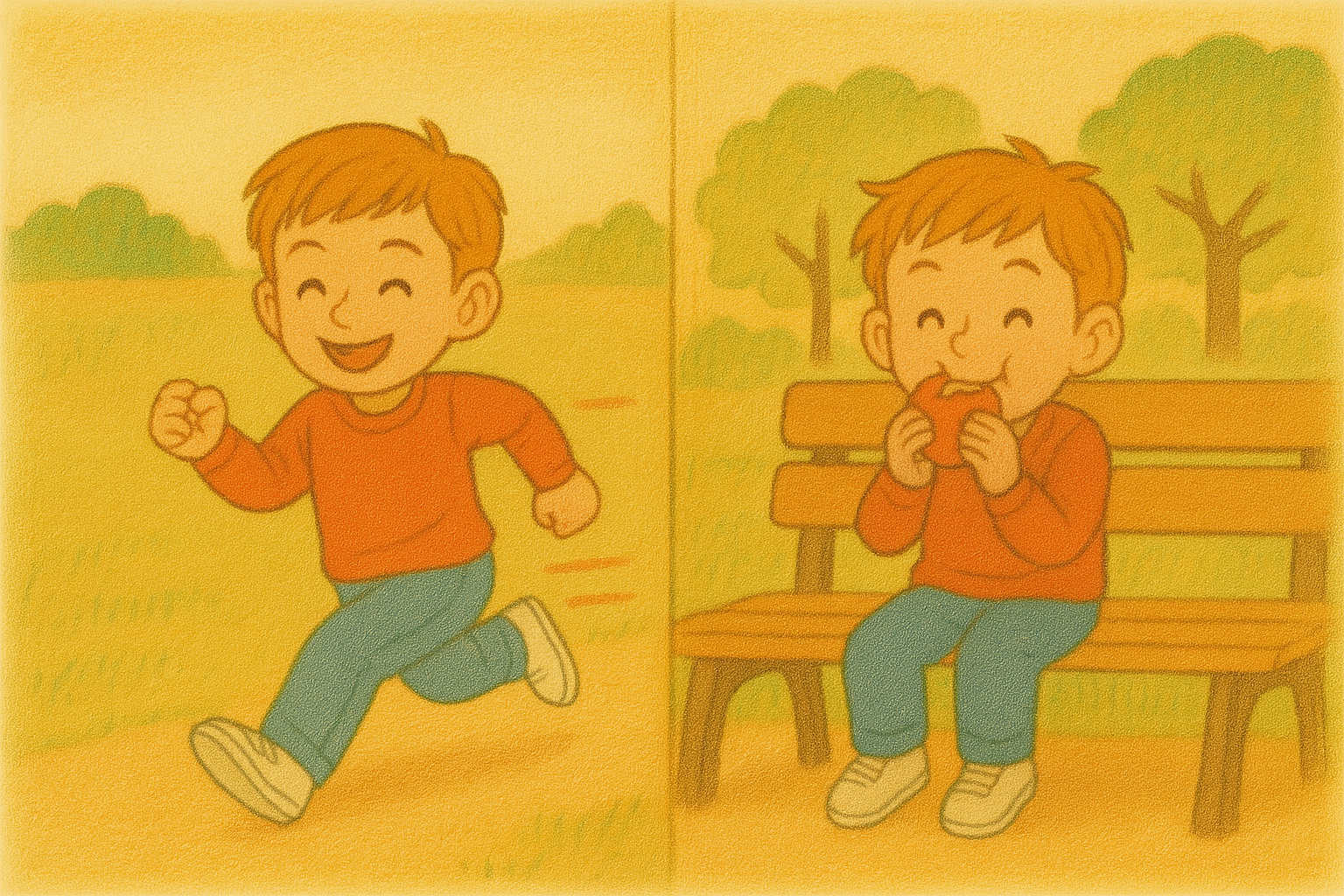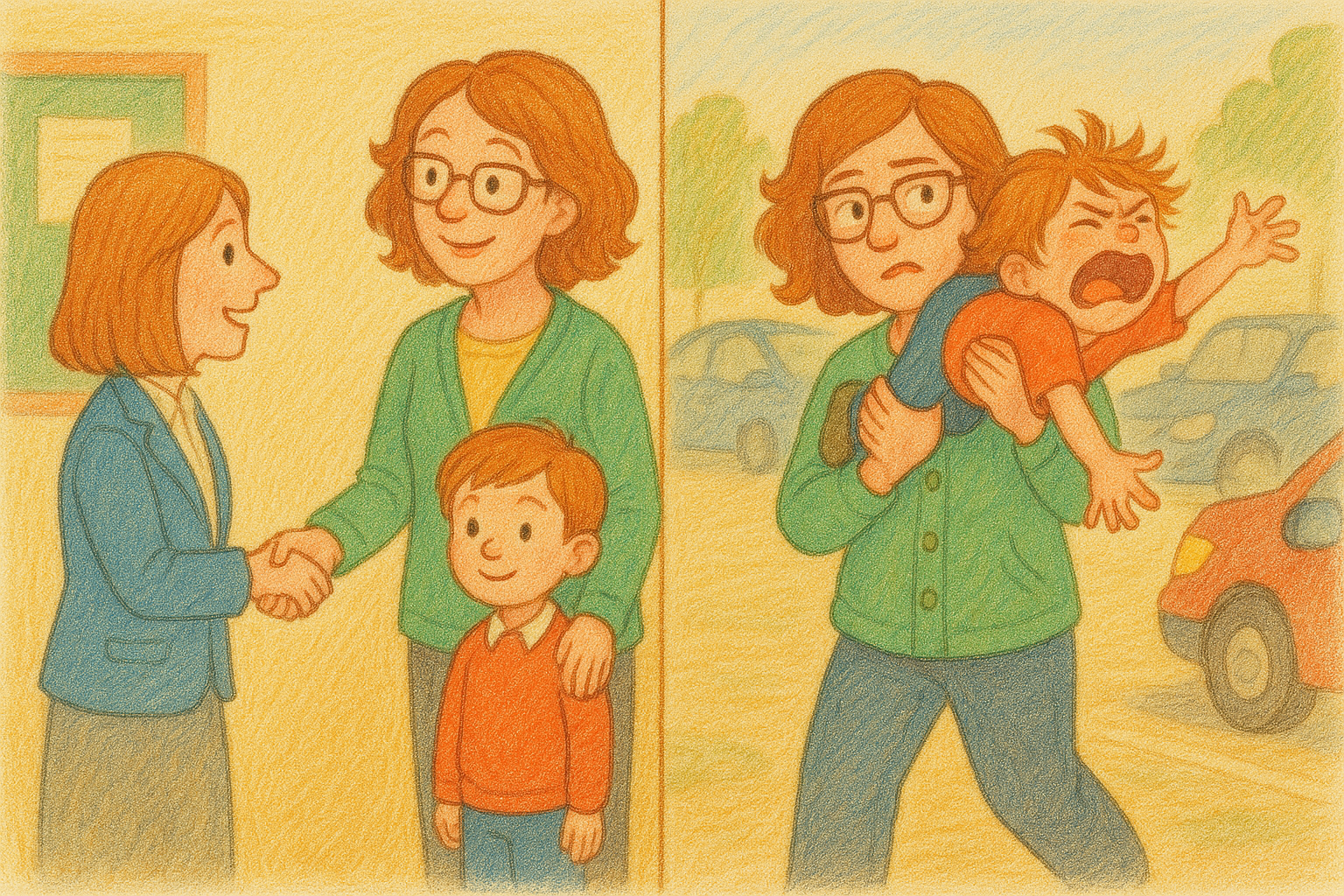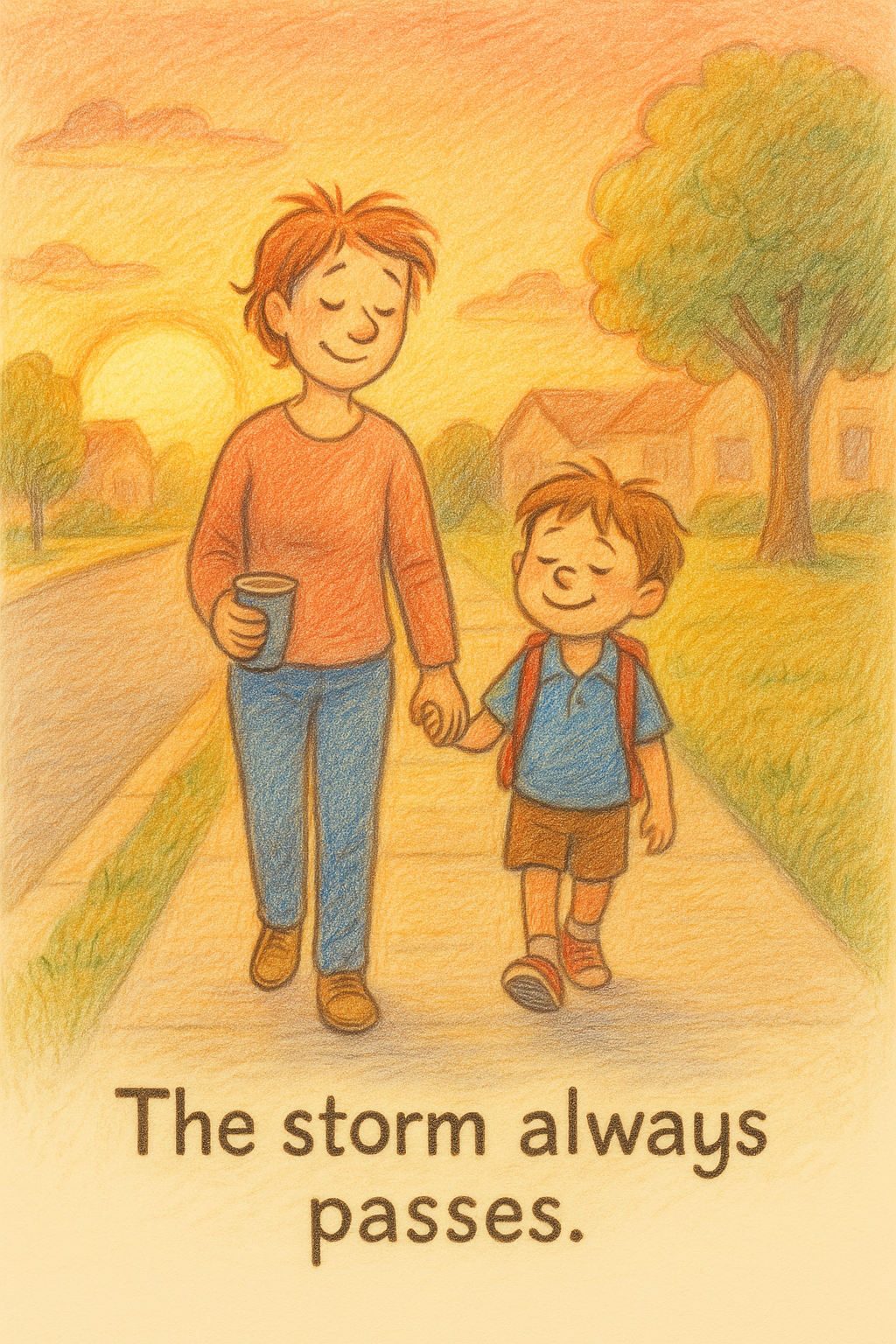Jekyll and Hyde Kids: Why Behaviour Changes When You’re Not Watching
Angel at School
Horror at Home
Ever picked up your child from school and been told, “They were an absolute star today!” while you’re still brushing crumbs off your shirt from the morning meltdown at home? You smile politely, but inside you’re screaming: “Are we talking about the same child?”
Welcome to the Jekyll and Hyde phenomenon of parenting: when your child behaves like an angel for teachers and then turns into a mini hurricane the moment they see you. It’s normal. Let’s unpack why it happens — and what you can do to survive the daily transformation.
Why It’s Easier to Hold It Together for Others
Have you ever noticed how easy it is to snap at your partner or close family but you’d never let rip the same way with a friend or neighbour? Sometimes just having a different person in the room is enough to keep your emotions in check. That’s because we naturally draw boxes around heightened feelings when boundaries exist.
That’s what teachers do at school. They set expectations, create routines, and craft an environment that feels predictable and structured. Those boxes help children keep their emotions contained during the school day.
We’re not suggesting that home isn’t predictable or trustworthy — it is. In fact, it’s the extreme version of safe. Home is where kids know the rules of unconditional love are non-negotiable. And that safety is exactly why they let their emotional boundaries burst wide open the moment they walk through the door.
The Safe Zone Effect: Why You Get the Storm
Children save their biggest feelings for the person they feel safest with — that’s you. Home is their comfort zone, where the emotional masks come off.
At school, kids follow routines, hold it together, and spend hours trying to be “good.” That’s a lot of pressure for a little person. When the bell rings, guess who gets the emotional explosion? You. Because they know you can handle it.
“Think of it like this: you don’t throw your laptop across the office when a meeting runs late — but you might mutter a few choice words the second you’re in your car. You’d never blow out someone else’s birthday candles just because you’re tired and hungry, either. Toddlers? They’d do both, without hesitation — no filter, full performance.”
The Control Bank Theory
Picture your child’s self-control as a battery. At school, every instruction — “Sit here, share that, wait your turn” — drains that battery. By the time they get home, it’s flashing red. One “wrong colour cup” later… meltdown.
It’s Not Manipulation (Even If It Feels Like It)
When your child gives teachers their halo and saves the chaos for you, it’s not because they’re trying to wind you up. It’s because you’re their safe harbour. They know home = unconditional love, and they can let it all out without fear of rejection.
In other words, you’re the soft place they land after holding it together all day. Exhausting for you? Yes. A sign of strong attachment? Also yes.
Why This Is Common in the Early Years
Separation Stress: They’ve just spent hours away from their secure base (you).
New Environment Overload: Reception classrooms are busy, bright, and full of rules. That’s a lot to process for a 4-year-old brain.
Emotional Regulation Still Developing: Kids don’t yet have the skills to manage big feelings on their own, so they offload them where they feel safe.
Explore their After-school Needs
At the end of the day, try to think about what your child actually needs — not just what you need them to do.
Maybe it’s a long, wild run in the park to shake off the structure of the school day.
Maybe it’s unhurried, un-timed play where no one interrupts or corrects them.
Maybe it’s an “energy rescue” — like a small snack (varying the snack can help prevent a habit).
Sometimes, your child might just need to show off.
Think about it: they’ve spent the whole day trying, learning, and sometimes failing — but without much chance to “perform” those new discoveries for anyone. They couldn’t show off every new skill, every doodle, every small win (or dramatic fall). So when they get home, that need to be noticed, praised, and seen bubbles up. Basically, they might be hunting for some undivided one-to-one attention — and they’ll get it however they can, whether through chatter, chaos, or clinginess.
The best defence? Eye contact and ears at pick-up time. Many schools now post signs saying, “Greet your child with a smile, not a phone.” It’s a small thing, but it matters. You won’t manage it every day — life happens — but try to make the phone the exception.
If you know the meltdowns or mood flips are coming, get ahead of them. Offer a quick distraction before things unravel:
“I’ve got a challenge for you,” or “Here’s a special project.”
That kind of language works because it sounds like school — structured, purposeful, and “important.”
What sort of projects? Anything that gives them purpose and control:
Reorganise the Tupperware cupboard and match lids to boxes.
Sort colouring pencils and pens by colour (even if it only stays that way for an hour).
“I need to draw a rainbow picture for work, but I don’t know where to start — can you help me with this project?”
Or try a few more:
Give them a wet cloth and say, “You’ve got five minutes to find ten fingerprints — go!”
Hand over a pile of odd socks and say, “Let’s see who finds the most matches.”
Ask, “Can you find all the books in our collection about dinosaurs? I need them for my special project.”
You’re not entertaining them; you’re redirecting them — giving their tired brain something predictable, achievable, and satisfying.
How to Survive the After-School Switch
How to Survive the After-School Switch
If you’re met with silence, sass, or sudden tears after pick-up, it’s not a sign your child’s turning into a tiny tyrant — it’s a crash landing from a long day of holding it all together. They’ve been “on” for hours — listening, sharing, following rules, taking turns, using their inside voice — and now they’re home, where they can finally drop the act.
Think of it as an emotional power cut. All their self-control gets used up at school, and when they walk through the door, the lights go out.
The trick? Don’t take it personally. Don’t rush into questions or try to fix their mood. Instead, go for predictable, low-pressure routines: a snack that doesn’t need a debate, quiet time before homework, or just letting them flop on the sofa in silence.
You can’t prevent the after-school switch, but you can soften the landing — and that’s what survival looks like.
When to Worry (And When Not To)
If the behaviour at home is extreme and teachers notice similar challenges at school, it’s worth a chat with your child’s teacher or SENCO. But if school reports are glowing and you only see this at home? It’s almost always emotional offloading, not a red flag.
Why Knowing This Helps with School Readiness
Understanding your child’s “two sides” — the calm one for school and the chaotic one for home — changes how you see their readiness. It’s not about acting perfect all day; it’s about having the emotional stamina to manage ups and downs in different environments.
Children who melt down at home aren’t failing at school readiness — they’re showing you they feel safe enough to decompress. That’s emotional development, not regression.
Knowing this helps parents stop asking, “Why are they fine for everyone else?” and start thinking, “They trust me enough to let it all out.” That’s a win, not a weakness.
When you can spot the pattern — and prepare for the switch — your evenings become less about firefighting and more about understanding what your child’s showing you.
Final Word: Ride It Out
When the switch hits, ride it out.
Don’t try to lecture mid-meltdown, don’t threaten consequences you’ll regret, and don’t spiral into guilt about why your child “saves it all” for you. They’re not doing it to you — they’re doing it with you.
Give them food, space, calm, and connection. And when the storm passes, praise the recovery, not the chaos.
You’ll get better at reading the early warning signs. They’ll get better at coping with the transition.
You’re both learning how to land safely after a long day apart. That’s school readiness too — for both of you.
The good news? It won’t last forever. As children grow, their emotional regulation improves, their independence grows, and those after-school storms ease off. School routines and social skills start doing some of the heavy lifting for you.
Until then, the best strategy is to ride it out with empathy and structure. Plan for calm, lower the after-school demands, and remind yourself: this wild energy is a sign of trust, not trouble. One day you’ll swap tantrum management for eye rolls and “Mum, stop embarrassing me.” And honestly? You might miss the days when the biggest drama was the wrong colour cup.
More guidance
If you haven’t read it yet, check out our “Goodbye With Confidence” guide, packed with practical tips to make separation smoother and help your child feel secure when away from you.













